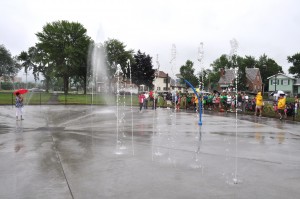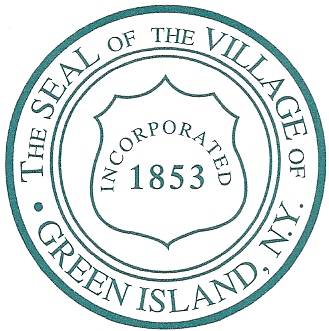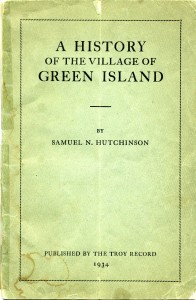Click here to read about Henry Ford’s role in the history of the Green Island Power Authority.
Compilation of Village of Green Island History
February 22, 2005
Green Island is a unique village rich in history and culture all packed into a square mile. With only about 2,620 residents, Green Island has an immense impact on its citizens and neighboring communities. It was originally one of two communities in New York State where the incorporated village and town have the same boundaries.
The Village of Green Island is comprised of three distinct islands – Green Island (the main residential and industrial section), Center Island (known as Starbuck Island in the 1800’s, now a residential part of the village) and McGill Island, which is near Center Island. The Hudson and Mohawk Rivers surround Green Island. Originally, in the late 1600’s and early 1700’s, the village was a chunk of land called Manor Rensselaerwycke and was owned by Colonel Kiliaen Van Rensselaer. Throughout the 18th century, several families owned different sections of the village. The Tibbits family was the first to own all of Green Island in 1835.
In the 18th and 19th centuries, the rivers surrounding Green Island attracted Native American tribes to the village. Findings of skeletons and arrowheads in the 1800’s have led historians to believe that part of the French and Indian War may have been fought where the Troy-Green Island Bridge is today.
Green Island caught the industrial bug that was spreading throughout the world after the Industrial Revolution. Railroads were an integral part of the rapid industrial growth of the village. Green Island was the terminal for the Rensselaer and Saratoga Railroad, making it the chief eastern terminal of the New York Central lines. Green Island was also the home of Eaton and Gilbert Car Works beginning in 1853. The company was known worldwide for their superb manufacture of railroad cars. Eaton and Gilbert built the first sleeping cars, drawing room cars, and electric cars. They even built a railroad car for Don Pedro, then the Emperor of Brazil. In addition to the railroad industry, Green Island was also home to a sawmill, a successful stove foundry, and factories specializing in the manufacture of scales and malleable iron.
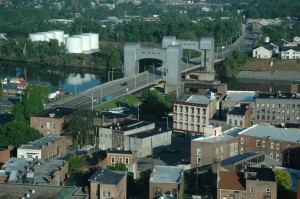 In less than 20 years, Eaton and Gilbert helped to expand the population of Green Island by almost 2,000 citizens, thus making the village more residential. In April 1853, the Village of Green Island was officially granted the right and power under New York State law to have its own government. In June of that year, the first elections were held for president of the village and for village trustees. (The political system of the village changed in 1944 when the office of the president was nullified and the first mayor of Green Island was elected.) Four churches were in existence in the village at this time (only one of these, the Church of Good Shepherd, is in operation today), and the original police force and fire company that were established in the 1800’s still exist today.
In less than 20 years, Eaton and Gilbert helped to expand the population of Green Island by almost 2,000 citizens, thus making the village more residential. In April 1853, the Village of Green Island was officially granted the right and power under New York State law to have its own government. In June of that year, the first elections were held for president of the village and for village trustees. (The political system of the village changed in 1944 when the office of the president was nullified and the first mayor of Green Island was elected.) Four churches were in existence in the village at this time (only one of these, the Church of Good Shepherd, is in operation today), and the original police force and fire company that were established in the 1800’s still exist today.
Industry and business have helped to develop the village as a whole. Another industry that built Green Island is the automobile industry. The Ford Motor Company built a plant on Tibbits Avenue in 1923. The plant covered 145 acres of land and employed about 900 workers per year. Henry Ford, Harvey Firestone and President Warren Harding were on site for the groundbreaking of the plant. The workers at the plant produced radiators and heater cores for over 60 years, which not only benefited the Ford Motor Company, but also made the economy of the village prosperous.
The residents of Green Island have always possessed a sense of duty when it comes to the good of the community and to the country. During the First World War, the Green Island Knights of Columbus sent 20 of their men to the front lines. The Legnard-Curtin Post American Legion #927 was established in 1920 and keeps an active interest in the community to this day, and Green Island puts on a Memorial Day parade each year to honor veterans and those who made the supreme sacrifice for our Country.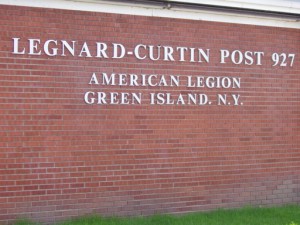
The Village of Green Island has also put forward a great effort to provide a safe and enjoyable environment for its children. In 1939, plans for the Paine Street Park went underway. Today, the park contains a playground, sprinkler park, basketball courts, and a pavilion so that the children of Green Island have a safe place to play. In the late 19th and early 20th centuries, Center (Starbuck) Island was a popular place to play baseball. Babe Ruth was amongst the baseball stars that played there. That tradition is carried on to this day through the Green Island Little League, which was created in 1954 by the Ford Motor Company, the Kiwanis, and the Catholic War Veterans. The Ford Little League team in Green Island was the first in the nation sponsored by Ford Motor Company. Green Island is also the home of Veteran’s Memorial Stadium, which includes fields used for golf, baseball, softball, and soccer, and a track for running. Men who worked as a part of the Works Progress Administration built the Stadium in 1941, under the program established by President Franklin Roosevelt’s New Deal, which was created to help ease the effects of the Great Depression. The WPA also provided surplus goods to families in need in Green Island during this time.
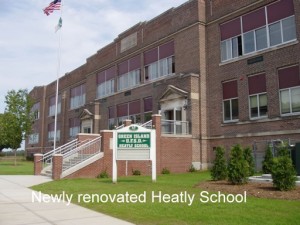 Education has always been a top priority to the citizens of Green Island. The first school was built in Green Island in 1865, and a second was built to accommodate excess students in 1879. Heatly School – currently the only school in the Green Island School District – was built in 1930. It expanded gradually from an elementary school to a high school, and in 1937, the first high school class graduated from Heatly. The school is named after James Heatly, who was the Superintendent of Schools from 1880 to 1924. Heatly School was renovated in the 1950’s and an addition, including a new gymnansium, laboratories, additional classrooms and other renovations were built beginning in 2006.
Education has always been a top priority to the citizens of Green Island. The first school was built in Green Island in 1865, and a second was built to accommodate excess students in 1879. Heatly School – currently the only school in the Green Island School District – was built in 1930. It expanded gradually from an elementary school to a high school, and in 1937, the first high school class graduated from Heatly. The school is named after James Heatly, who was the Superintendent of Schools from 1880 to 1924. Heatly School was renovated in the 1950’s and an addition, including a new gymnansium, laboratories, additional classrooms and other renovations were built beginning in 2006.
Green Island continues to be a village of economic and cultural prosperity. Businesses currently in operation include Lydall-Manning (a paper company), Sealy (a plant that manufactures mattresses), Honeywell (which produces friction materials), Ross Valve (former Zak), Silhouette Optical (eyewear), the Green Island Lanes (a bowling alley), the McNulty Funeral Home and a number of corner stores and hair salons. A few active organizations on the Island include the Green Island Senior Citizens (established in 1970 to provide recreational activities for older residents), the Vagabond Club, the Green Island Little League and the Youth Organization of Green Island (YOGI) basketball program (established in 1971).
Green Island is a town that has been dedicated not only to the well being of its inhabitants, but also to the success of industries around the nation. In his History of Green Island (1934), resident Samuel Hutchinson said that he wrote his account of the village “to correct the idea which some people profess to believe – that Green Island is good enough to live in only as long as one has to.” Hutchinson believed not only in the past, but also in the future of Green Island. “It behooves us to remember that Green Island is and will be just exactly what we make it…to be a dweller of the community is a privilege which is worth treasuring.” It is clear that the many generations of “Islanders” before and since Hutchinson agree.
References:
- Manuscript of Samuel N. Hutchinson as published in The Troy Record, June 25, 1934.
- Green Island Heritage and the Bicentennial
- Green Island Bicentennial Commission, July 4, 1976.
Green Island Remembers Hurricane Irene
Click on link below for Hurricane Irene synopsis by Executive Assistant to the Mayor and Emergency Management Administrator Sean Ward one year after it made its way up the east coast of our country before finally hitting New York State and the Capital Region on Sunday, August 28, 2011:
Green Island Bridge Collapses on March 15, 1977
Click on link below for reflections on the 40th anniversary of the collapse of the Green Island Bridge.
https://villageofgreenisland.com/uncategorized/40-years-ago-today/
Construction History of the Paine Street Park
We came across this construction history of the Paine Street Park in the Green Island Bicentennial book (The present day 1993 through 2013 material based on recollection and records).
1939: A committee was formed to inquire about the purchase of property for a new park. The two block area (as it sits now) was purchased by the Village from Mr. S. DeStefano. Houses were torn down and the park was built with playground equipment, wading pool, restrooms, tennis and basketball courts.
1975: Extensive improvements with new modern equipment and a fence around just the playground area. The remainder of the park remained without fencing.
1993: A $250,000 makeover with fencing around the entire park; resurfacing of basketball courts, ice rink (north of basketball courts) and wading pool; additional basketball court constructed, giving us three; new “stadium type” lighting with underground wiring on courts and rink and enhanced lighting throughout park; installed large, new playground equipment; installed new benches and added picnic tables throughout the park.
2008: A 20’W X 40’L X 10’H pavilion was constructed in the former ice rink area of the park with picnic tables added underneath. The $30,100 project was partially funded with a $25,000 grant from Albany County with the Village share being the remainder.
2013: With a very generous $200,000 donation from Green Island resident lottery winners John and Lynda Kutey, in honor of their parents Edmund and Gertrude Ostrowski and Joseph and Mercedes Kutey, a new, modern Spray Park was built to replace the old wading pool that needed serious repairs and was many years outdated. Jim Besha, Sr. and his company, Albany Engineering, donated the design engineering for the project which was dedicated on July 1, 2013.
2018: A modern and ADA compliant playground was purchased and constructed with $125,000 in Legislative Initiative Grant funding sponsored by New York State Assemblymember John McDonald.
